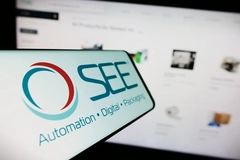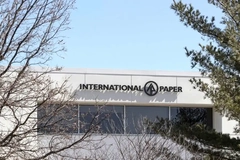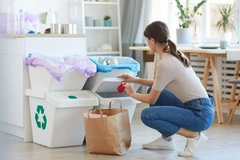Reduction or recycling? How packaging experts are fighting to slash emissions footprints

23 Aug 2023 --- Material reduction lies at the heart of the circular economy and industries’ efforts to lower their environmental footprints. With growing consumer demands, legislation and economic challenges, many businesses are working to redesign and restructure their products and operations in the face of increasingly stringent marketplaces.
Reduction comes in many forms: Switching from fossil-based to renewable resources is a central tactic, along with improving product recyclability, infrastructure and consumer compliance. Reusable and refillable packaging formats are also hitting store shelves at a rapid rate.
While debates over which tactics should be prioritized and what is the most effective in different scenarios, lightweighting products remains one of the most assured and impactful methods. Environmental and financial sustainability improvements are generally guaranteed where material usage can be simply decreased.
However, some industry experts say that unless improvements to recycling are established, reduction will only go so far in helping the industry advance.
Marcel Veenstra, marketing and communications manager at Sealpac, tells Packaging Insights that the company is actively working on reduction ahead of switching to renewable material resources.
“We support our customers in the food industry by reducing the thickness of plastic used in their current packaging, as well as by introducing hybrid solutions, where most of the plastic is replaced by cardboard,” he says.
“In the case of hybrid solutions, we enable the consumer to separate the individual materials after use. By throwing these materials away in the appropriate waste bins, recycling is made easy. With regard to 100% plastic packaging, we have optimized our traysealers to handle so-called ultra-light trays.”
 An example of Sealpac’s material-reduced packaging.Reduction as the key?
An example of Sealpac’s material-reduced packaging.Reduction as the key?
Circularizing the economy is currently one of the focal points of the EU’s Green Deal and a target for many countries around the globe, whose governments and industries are struggling to achieve the net zero targets established in the Paris Climate Agreements.
With time running out, companies like Sealpac are demonstrating how their customers can claim active and successful attempts to abide by these tightening legislative requirements.
But a central challenge also lies in assuring that F&B products are protected and that their shelf lives are extended as far as necessary. Food waste remains one of the globe’s main sources of GHG emissions, with the US FAO estimating that 14% of the world’s food, valued at US$400 billion, is lost annually between harvest and the retail market.
At the same time, an estimated 17% of food is wasted at the retail and consumer levels. Once landfilled, wasted food produces roughly 8-10% of global GHG emissions, most of which is methane – a gas 80 times more potent than carbon dioxide.
“The primary role of packaging is to protect the product inside to guarantee maximum life span. In the case of food, we talk about maximum shelf life. For some products, it is possible to do without packaging, but for most food items, this is not an option,” emphasizes Veenstra.
“One always has to look at the total footprint, including the product itself. In the case of fresh food, it may well be that the product makes up 90% of the footprint and the packaging 10%.”
When this is the case, products with some amount of plastic are still the better option, he asserts.
“In other words: ‘As little plastic as possible, as much as necessary.’ If the product carrier requires a certain amount of stability, there is the option of using a hybrid solution, where most plastic is replaced by recyclable cardboard.”
Tackling carbon and “re-looping”
Reducing food waste may be the focal point of packaging revisions, but in terms of packaging industry materials and operations, some experts maintain tackling carbon must be the starting point.
Professor Ed Kosior, founder of Nextek and Nextloop, says that CO2 emissions are the “key issue” for the packaging industry.
“By avoiding the production of virgin plastics through the use of high quality and food-grade recycled plastics such as PP, HDPE and PET, significant CO2 emissions can be avoided,” he says.
This is one of Nextek and Nextloopp’s central focuses through the technologies it has developed for these plastics. Each ton of recycled plastic saves at least one ton of CO2, the company claims.
In the case of food-grade recycled PP (FGrPP), an estimated 1.6 tons of CO2e can be saved compared with using virgin PP resin. An example of Nextloopp packaging.
An example of Nextloopp packaging.
“Of course, ‘packaging design for improved recycling’ is also a key focus for every application of plastics as this simplifies and boosts the recycling process, allowing greater yields and improved quality,” Kosior continues.
“One of the challenges facing packaging designers is the trend to adopt alternative materials that might appear appealing to consumers yet might be a material composition that is difficult to recover and recycle.”
“This points out the need to make comparisons carefully using the carbon footprint for the recovery steps in the locations where the recycling is happening given that many locations may not have access to the recycling resources.”
Infrastructure improvements
Careful comparisons are especially needed when materials like foils, pouches and laminates of plastic and paper might represent reductions in material yet be very challenging to recycle, which can lead to little or no reduction opportunities for these materials in the next cycle and, consequently, a continuation of high CO2 emissions, explains Kosior.
“The best choices would involve using the materials which have low carbon footprints and are readily recyclable, so once packaging weights are optimized, the lowest CO2 emissions would be the result.”
“The challenge facing brand owners is to be able to ensure that any assumptions about recycling infrastructure are applicable to the regions where they sell their products and packaging.”
The Nextloopp project has developed over 40 products with recycled contents of at least 30% and higher. This has been achieved with brand owners by developing unique sorting and decontamination technologies called POLYPPRISM for sorting and PPRISTINE for decontamination technologies.
Nextek has also developed other technologies that allow the re-looping of plastics, including COtooCLEAN, which uses supercritical CO2 as a fluid to decontaminate film plastics back to food grade.
“A paradigm shift in the current design guidelines for circular packaging has the potential to transform recycling rates,” says Kosior. “The guideline alterations I have in mind would enable us to go beyond recycling – which traditionally results in converting materials from used products into new materials for (mostly) lower value products – to what I define as re-looping.”
Re-looping means turning post-consumer packaging back into high-quality packaging. “In other words: Instead of recycling plastic packaging to achieve commodity resins, we re-loop plastic packaging into the highest quality resins possible.”
“The technology exists to achieve this. The challenge, however, is the disconnect between what brand owners and retailers are putting onto the market and what they require to meet their sustainability goals – namely high-quality recyclates,” asserts Kosior.
“Reducing materials will, of course, go some way toward reducing a pack’s carbon footprint, but the real issue is being able to turn packaging back into high-quality packaging – that will make the biggest difference.”
By Louis Gore-Langton











